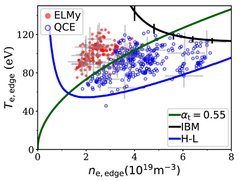Forward-looking studies on heat removal for reactor concepts successfully carried out at ASDEX Upgrade
One of the greatest challenges of fusion research on tokamaks is to achieve optimal plasma energy confinement while minimising the heat load on the reactor walls. The 'Quasi Continuous Exhaust' regime - QCE for short - promises to combine both aspects.

The 'High Confinement Mode' - H-mode for short - discovered in ASDEX achieves the best possible energy confinement for future fusion experiments such as ITER, but is accompanied by periodically occurring plasma instabilities, called ELMs (Edge Localised Modes). In a fusion reactor, ELMs are undesirable because they put a lot of stress and wear on the reactor wall. The QCE regime is an attractive regime in which ELMs are suppressed by increased turbulence at the outermost plasma edge without sacrificing much confinement quality.
A recent work investigates the conditions for reaching the QCE regime at ASDEX Upgrade. For this purpose, experimental data points of the outermost plasma edge were plotted in a density-temperature diagram (see picture). The operating range of the H-mode lies within two limits. The minimum temperature for reaching H-mode with good energy confinement is given by the blue line. The black line represents the maximum achievable pressure gradient. A subdivision between plasma conditions with and without ELMs is indicated by a new (green) line, which represents a threshold value in the turbulence parameter αt, which is a measure of the strength of the local turbulence.
The publication on this work can be found here: M. Faitsch et al, Analysis and expansion of the quasi-continuous exhaust (QCE) regime in ASDEX Upgrade, Nuclear Fusion 63, 076013 (2023).
